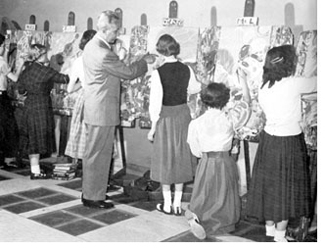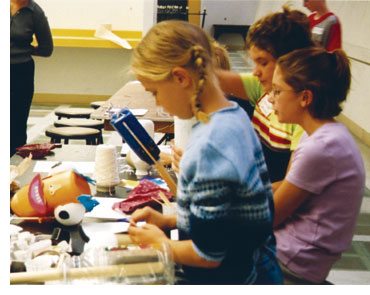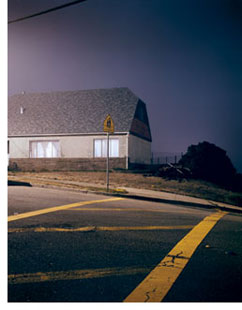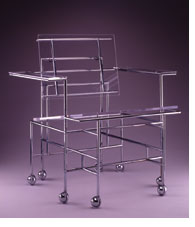
Saturday Art Classes Celebrate
By Lorrie Flom
Because of the stock market crash and the onset of
the Great Depression, the year 1929 didn’t bode
well for most Americans. But for a small group of budding
artists, it was a wonderful time to join the new Saturday
art classes at Carnegie Museum of Pittsburgh. The popular
classes, then called Tam O’Shanters and Palettes (and
later the Saturday
Creative Art Classes and The
Art Connection), would prove to have a profound
influence on thousands of students during 75 years
of continuous
operation.
 During
the early years, under the direction of legendary art
instructor Joseph Fitzpatrick,
hundreds of students would pack Carnegie Music
Hall each Saturday for a lecture and demonstration,
hearing
their mentor repeat this mantra at the end of each
lesson: “Look…to
see…to remember…to enjoy.” During
the early years, under the direction of legendary art
instructor Joseph Fitzpatrick,
hundreds of students would pack Carnegie Music
Hall each Saturday for a lecture and demonstration,
hearing
their mentor repeat this mantra at the end of each
lesson: “Look…to
see…to remember…to enjoy.”
Tam O’Shanters and Palettes in
the 1950s.
Since
then, the classes have shifted to a hands-on learning
approach within a studio setting. Marilyn
Russell, curator of art education, says, “Education
has changed throughout the years. We now know that
young people learn best through experiential learning,
and our Saturday classes reflect this change in
approach.” The
180 current students in grades 5 through 9 attend
The Art Connection each Saturday for 18 weeks,
focusing on such themes as the natural world, ancient
civilization,
art in everyday life, art and identity, and art
as it reflects time and place. Approximately half
of
the
students come from the Pittsburgh Public Schools,
which provides full scholarships for its students.
The remaining
students pay to attend and come from throughout
the region—with recommendations from art
teachers, or at the urging of parents, many of
whom attended
the Saturday classes as children.
 The
Art Connection now. The
Art Connection now.
Visitors to the
Museum of Art on Saturdays are accustomed to
seeing Art Connection students sketching
or discussing
works of art—a key part of the process of
developing their creative skills—in the
studios that overlook the Hall of Architecture.
“This 75-year anniversary allows us to celebrate
the importance of participation in arts for all kids,” says
Russell. “Many of our graduates go on
to careers in the arts, but our program is
not about creating
famous artists. It’s about sparking the
imagination, encouraging kids to be curious
about the world, and
finding ways to express their own ideas.”
UPDATE:

A Showcase of Contemporary Art
that Will Not Disappoint
The Carnegie International traces
its roots to an exhibition series begun in 1896
by Andrew Carnegie, whose goals
were to feature contemporary artwork, attract the
public to Pittsburgh, and establish a museum of modern
art.
Today, the now triennial Carnegie International is
America’s preeminent showcase of contemporary
art from around the world.
The Carnegie International
2004, scheduled to open October 9, 2004, “will
not disappoint its viewers,” says
Curator Laura Hoptman, who has traveled repeatedly
to 20 countries to assess art and artists, and
to identify themes. “This exhibition is three
years in the making,” says Hoptman. “When
we develop an exhibition, we are making an argument,
and that
takes a great deal of planning.”
An unusually
high percentage of art is being made specifically
for the exhibition. “We encouraged many
artists to create new works for the International,” says
Hoptman. “We want this to be the place
better-known artists premiere their new works.”
Hoptman
also says the last International saw a return
of painting. “That trend is continuing,” she
says. “We will see more traditional objects—paintings,
sculpture, drawings—while also incorporating
installations, film, video, ceramics, popular
illustration, and animation.” The 2004
International will feature a wider variety of
artists than the previous exhibition,
however.
“The last time, we featured the best-known artists
of our time,” explains Hoptman. “This time,
our artists range in age from 27 to 80, and
include relatively unknown young artists, older artists
with
notable work, and artists who are enormously
well known internationally.”
Terrain Vague: Photography, Architecture, and the
Post-Industrial Landscape
Heinz Architectural Center March 20 - June 20, 2004

Catherine Opie, Untitled
#1, From the Mini-mall series,
1997,
courtesy Regen Projects, Los Angeles.
The urban and suburban environments are full of ambiguous
spaces—where architecture and the environment
don’t mesh, where the space is in some way strange,
unresolved, or unsettling. Perhaps it’s a crumbling
steel mill, a vast pile of discarded tires, or a suburban
development backed by mammoth transmission towers. “Terrain
vague” is the term coined by architect and critic
Ignasi de Solà-Morales to describe these sites.
Solà-Morales focuses on the divergent ways in
which architects and photographers view these spaces.
Architects, he says, attempt to impose order and form
on such spaces, while photographers and other artists
prefer to capture “these alternative, strange
spaces…and their uncontaminated magic.” Solà-Morales’ concept
comes to life in an exhibition, also called Terrain
Vague.
 Todd
Hido, #2077, from the series House Hunting,
1997, courtesy the artist. Todd
Hido, #2077, from the series House Hunting,
1997, courtesy the artist.
The
exhibition includes works by 10 internationally known
artists, including photographers Martha Rosler,
Edward Burtynsky, Todd Hido, and Philip-Lorca di
Corcia, and video artist Andy Anderson. Organized
by a photographer
and an architect at Georgia Institute of Technology,
the show was brought to Carnegie Museum of Art
by Tracy Myers, curator of architecture. “Some visitors
might wonder why photography is being presented in
the Heinz Architectural Center,” says Myers. “I
feel it’s important for the department to present
exhibitions about what building and the built environment
mean…how places are endowed with meaning through
their use.” Myers adds, “I’d like
people to come away with questions about the ambiguous
spaces in their own environment.”
Recent Aquisition:
Rolling Armchair, 1968
New Chair Rolls into Decorative Arts Collection
 Paul
Rudolph, American, 1918-1997, Rolling Armchair, 1968,
lucite and chromium-plated tubular steel. Decorative
Arts Purchase Fund. Paul
Rudolph, American, 1918-1997, Rolling Armchair, 1968,
lucite and chromium-plated tubular steel. Decorative
Arts Purchase Fund.
Paul
Rudolph, a noted modernist architect, was known
as an educator (he was chair of Yale’s Department
of Architecture from 1958-1965) and for his building
designs worldwide. Like many architects, he was interested
in furniture design as well, creating several significant
pieces during his career. Among them is the Rolling
Armchair, designed in 1968. This chair design,
of chromium-plated tubular steel and Lucite, was
never
mass-produced, but was used in his private commissions
as well as in his New York City apartment as a
desk chair. “ The Rolling Armchair pays homage
to Marcel Breuer’s
iconic 1927 Wassily Chair, one of the earliest
tubular steel chairs produced,” says Sarah
Nichols, curator of decorative arts. “What’s
interesting about the Rudolph chair is that where
Breuer uses
leather as upholstery, Rudolph uses Lucite, which
was a popular ’60s design element.” Rudolph
was interested in natural light, and made frequent
use of Plexiglas and other transparent materials
in his architecture to allow light to flow through
various levels of his buildings. In another salute
to the times, Nichols describes the chair’s
six legs and casters as reminiscent of a shopping
cart, a common object in post-WWII popular culture.
The Rolling Armchair is on display in Gallery 15
of the Scaife Galleries, in the company of chairs
by Warren Plattner and Charles and Ray Eames,
both of whom use steel rods in their designs. Nichols
believes the Rolling Armchair is a particularly
good addition because it supports other works
by
Rudolph
within the Museum—namely architectural
drawings that are part of the Heinz Architectural
Center
collection.
Twelfth Annual Antiques Show Blends
History, Royalty
April
16-18, 2004
Last year, the Carnegie Museum of Art Antiques Show
featured 44 of the nation’s leading antique
dealers, along with guest speaker Mario Buatta, known
as the “Prince of Chintz” for his English
county style of decorating. This year, the Twelfth
Annual Antiques Show, April 16-18, 2004, will bring
more exquisite antiques to the Museum of Art, along
with royalty of a different kind. Great Britain’s
Princess Michael of Kent, whose reputation as an
engaging lecturer on art and history takes her around
the world, will be on hand for an April 16 lecture
on Madame de Pompadour, lover of France’s King
Louis XV.
As in the past, Carnegie Museum of Art’s
Women’s
Committee is hosting the Antiques Show as well as
a preview party on April 15 to benefit the Museum
of Art. Susie Katz, the event’s co-chair, says, “The
party, show, and lecture are a wonderful way for
the community to view and buy outstanding antiques
while supporting the Museum of Art.” More than
1,600 antiques lovers ogled—and purchased—exceptional
furniture, rugs, fine art, silver, and more at
the 2003 show, including 700 who attended both
the preview
party and show, and 900 who visited the three-day
event. The 2003 show grossed $270,000 for the Museum
of Art. Most of the dealers are returning this
year, along with several new ones: Birchknoll,
Leatherwood
Antiques, Mongenas Antiques, Philip Ludwig Antiques,
and Running Battle Antiques.
Back to Contents |